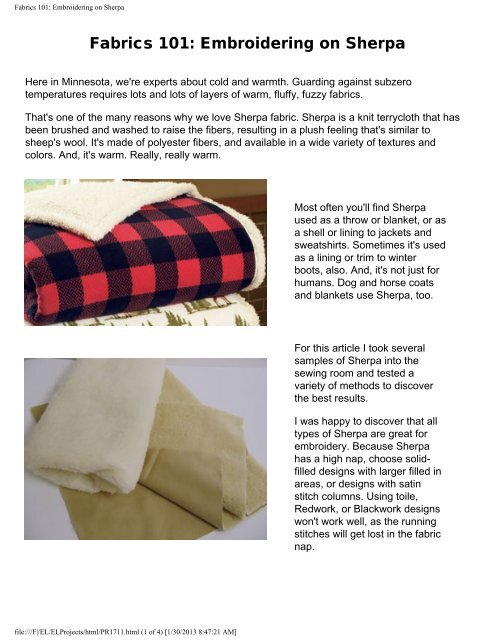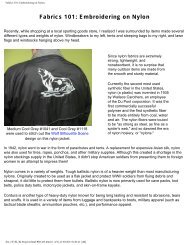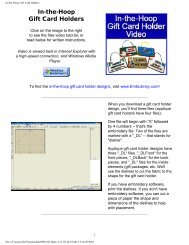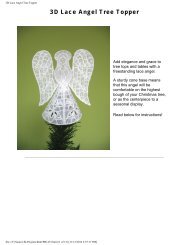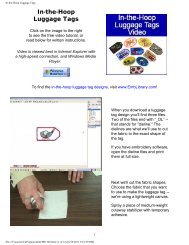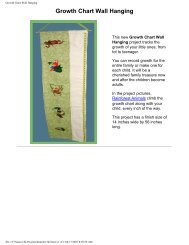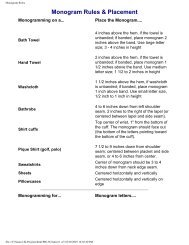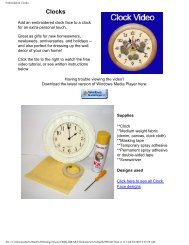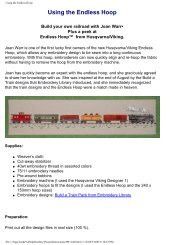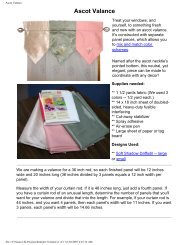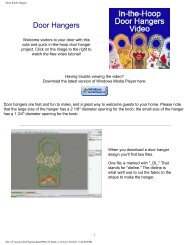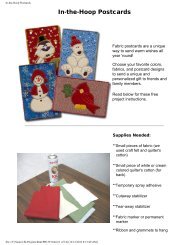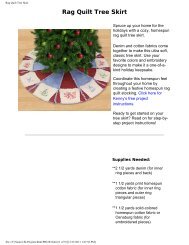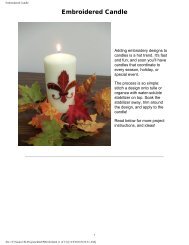Fabrics 101: Embroidering on Sherpa - Embroidery Library
Fabrics 101: Embroidering on Sherpa - Embroidery Library
Fabrics 101: Embroidering on Sherpa - Embroidery Library
You also want an ePaper? Increase the reach of your titles
YUMPU automatically turns print PDFs into web optimized ePapers that Google loves.
<str<strong>on</strong>g>Fabrics</str<strong>on</strong>g> <str<strong>on</strong>g>101</str<strong>on</strong>g>: <str<strong>on</strong>g>Embroidering</str<strong>on</strong>g> <strong>on</strong> <strong>Sherpa</strong><str<strong>on</strong>g>Fabrics</str<strong>on</strong>g> <str<strong>on</strong>g>101</str<strong>on</strong>g>: <str<strong>on</strong>g>Embroidering</str<strong>on</strong>g> <strong>on</strong> <strong>Sherpa</strong>Here in Minnesota, we're experts about cold and warmth. Guarding against subzerotemperatures requires lots and lots of layers of warm, fluffy, fuzzy fabrics.That's <strong>on</strong>e of the many reas<strong>on</strong>s why we love <strong>Sherpa</strong> fabric. <strong>Sherpa</strong> is a knit terrycloth that hasbeen brushed and washed to raise the fibers, resulting in a plush feeling that's similar tosheep's wool. It's made of polyester fibers, and available in a wide variety of textures andcolors. And, it's warm. Really, really warm.Most often you'll find <strong>Sherpa</strong>used as a throw or blanket, or asa shell or lining to jackets andsweatshirts. Sometimes it's usedas a lining or trim to winterboots, also. And, it's not just forhumans. Dog and horse coatsand blankets use <strong>Sherpa</strong>, too.For this article I took severalsamples of <strong>Sherpa</strong> into thesewing room and tested avariety of methods to discoverthe best results.I was happy to discover that alltypes of <strong>Sherpa</strong> are great forembroidery. Because <strong>Sherpa</strong>has a high nap, choose solidfilleddesigns with larger filled inareas, or designs with satinstitch columns. Using toile,Redwork, or Blackwork designsw<strong>on</strong>'t work well, as the runningstitches will get lost in the fabricnap.file:///F|/EL/ELProjects/html/PR1711.html (1 of 4) [1/30/2013 8:47:21 AM]
<str<strong>on</strong>g>Fabrics</str<strong>on</strong>g> <str<strong>on</strong>g>101</str<strong>on</strong>g>: <str<strong>on</strong>g>Embroidering</str<strong>on</strong>g> <strong>on</strong> <strong>Sherpa</strong>Using a 75/11 sharp needle willkeep the edges of the designcrisp and clean.Choose a medium-weight (2.0 or2.5 ounce) cutaway stabilizer. Acutaway helps to hold thestretchy knit weave of the fabricin place while embroidering.(Using a tear-away stabilizer willallow the fabric to shift and skewin the hoop, and you'll likely seegaps in the stitchout.)I used a lightweight watersolublestabilizer (Sulky Solvy)as a topping. Topping helpssmooth out the wooly surface ofthe fabric, and prevents thestitches from sinking in.You'll notice that I've hooped thefabric with the stabilizer. Thishelps to keep the stitches crisp,clean, and in the right place. Nothooping the fabric will result infuzzy stitches, and possiblygapping.Some embroiderers d<strong>on</strong>'t like tohoop bulky items, or items thatmay have a hoop ring (aka hoopburn) after the hoop is removed.However, because <strong>Sherpa</strong> ispolyester and washable, anyhoop marks will come out afterlaundering or steaming.file:///F|/EL/ELProjects/html/PR1711.html (2 of 4) [1/30/2013 8:47:21 AM]
<str<strong>on</strong>g>Fabrics</str<strong>on</strong>g> <str<strong>on</strong>g>101</str<strong>on</strong>g>: <str<strong>on</strong>g>Embroidering</str<strong>on</strong>g> <strong>on</strong> <strong>Sherpa</strong>After embroidering, unhoop thefabric and tear away the topping.Use a tweezers to remove anysmall bits of the topping. You canalso dab the fabric with a bit ofwater to dissolve the stabilizer,and the small amount thatremains will be removed whenlaundering.Hooping the <strong>Sherpa</strong> and usingcutaway stabilizer and a toppinggives great results! The stitchesare crisp and clear, and all thesecti<strong>on</strong>s of the design areperfectly aligned. The solid fillsand satin stitches make thisdesign stand out nicely <strong>on</strong> theplush, wooly fabric.When working with a premade garment, the most challenging part will be hooping and securingthe fabric so that it doesn't prevent the hoop from moving while embroidering. Using chip clipsor large hair clips will help c<strong>on</strong>siderably. Be sure to pin or clip sleeves, collars, etc. well out ofthe way so that the hoop can move freely and easily.Stitching tips for sherpa:NeedleStabilizerDesign Choice75/11 sharp needle; an embroider needle may also be usedCutaway (2.5 ounce)Solid-filled designs; avoid sheer or Redwork designs.file:///F|/EL/ELProjects/html/PR1711.html (3 of 4) [1/30/2013 8:47:21 AM]
<str<strong>on</strong>g>Fabrics</str<strong>on</strong>g> <str<strong>on</strong>g>101</str<strong>on</strong>g>: <str<strong>on</strong>g>Embroidering</str<strong>on</strong>g> <strong>on</strong> <strong>Sherpa</strong>Click here for a printable versi<strong>on</strong> of this article.You'll need to have Adobe Acrobat Reader installed <strong>on</strong> your computer. If you d<strong>on</strong>'t have it, youcan download a free copy by clicking <strong>on</strong> the ic<strong>on</strong> below.file:///F|/EL/ELProjects/html/PR1711.html (4 of 4) [1/30/2013 8:47:21 AM]


